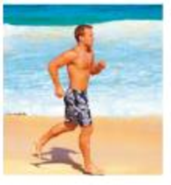
Concept explainers
Vibrio vulnificus Infection

Greg enjoyed Florida’s beaches; swimming in the warm water was his favorite pastime. Of course, the salt water did sting his leg where he had cut himself on some coral, but it didn’t sting enough to stop Greg from enjoying the beach. He spent the afternoon jogging in the pure sand, throwing a disc, watching people, drinking a few beers, and of course spending more time in the water.
That evening, he felt chilled, a condition he associated with having gotten too much sun during the day, but by midnight he thought he must have caught a rare summertime flu. He was definitely feverish, extremely weak, and tired. His leg felt strangely tight, as though the underlying muscles were trying to burst through his skin.
The next morning, he felt better, except for his leg. It was swollen, dark red, tremendously painful, and covered with fluid-filled blisters. The ugly sight motivated him to head straight for the hospital, a decision that like y saved his life.
Greg was the victim of an emerging pathogen, Vibrio vulnificus–a slightly curved, Gram-negative bacterium with DNA similar to that of V cholerae (cholera bacterium). V vulnificus lives in salty, warm water around the globe. Unlike the cholera bacterium, V vulnificus is able 10 infect a person by penetrating directly into a deep wound, a cut, or even a tiny scratch. In a person, the multiplying bacterium secretes quorum-sensing molecules. When the cells sense that there is a certain

Greg’s doctor cut away the dead tissue and prescribed doxycycline and cephalosporin for two weeks. Greg survived and kept his leg. Half of the victims of V. vulnificus are not so lucky; they lose a limb or die. Who knew that a beach could be so dangerous? (For more about quorum sensing, see pp.167-169.)
- 1. Why is it necessary for Vibrio vulnificus to turn on different genes when the microbe invades a human?
- 2. What does the term “turn on” mean in relation to transcription and translation?
- 3. Why do you think the related microbe V. cholerae is unable to infect through the skin?
Want to see the full answer?
Check out a sample textbook solution
Chapter 7 Solutions
EBK MICROBIOLOGY:W/DISEASES BY BODY...-
- The man pictured in Figure 4.17 wears skin ornaments applied by piercing. Among other functions, the skin is a barrier to potentially dangerous bacteria, and some people object to extensive body piercing on the grounds that it opens the door to infections. Explain why you do or dont agree with this objection. Figure 4.17 This young man has chosen to undergo multiple body piercings.arrow_forwardWhy can’t dogs catch the measles?arrow_forwardJack is a 77-year-old retired bank executive. During the last 15 years of his employment, he played golf regularly and frequently met with the 'boys' after that last hole for dinner and drink. Jack retired 5 years ago at age 68. Since his wife passed away 2 years ago, Jack has found his golfing outings to be more important than ever. Last month Jack had a righ knee replacement that 'went wrong.' His incision became infected and he had to have the procedure redone. Jack now has orders for 'no weight bearing' and is being seen by a home health nurse for daily IV antibiotics. Last week when his nurse visited and asked if he needed anything, Jack replied "I need a fifth of whiskey and a handgun." A) What disciplines would you involve in a care-planning meeting for Jack? Provide rational for your choices of inclusion and exclusion B) What teaching might be appropriate for Jak? Please need specific answer don't copy from internet or cheggarrow_forward
- A "cold sore" is actually a herpes infection. It produces blisters that ooze a clear fluid. The technical term for these blisters is ___. pustules vesicles varices carbunclesarrow_forwardLyme disease or zika virus https://www.ncbi.nlm.nih.gov/pmc/articles/PMC5729143/ https://www.hopkinsmedicine.org/zika-virus/what-is-zika-virus.html Which virus are you more concerned about? Some questions to think about for your answers: Are there available treatments? Be a health care provider: What would you recommend for your patients to avoid these viruses? Do your recommendations change in the mists of the Covid pandemic?arrow_forwardbe sure your answer is correct if u know correct answer then u try i have last posting please incorrect answer = thumbs downarrow_forward
- Backpacker-1 returns from 2 week hiking trip in Sierra Mountains. Reports sleeping on ground near openings to rodent/ground squirrel tunnels. Swollen lymph nodes and dark, discoration on fingers, fever. Stained blood smear shows Gram-negative bacteria, randomly arranged bacilli What is the name of the pathogen and what is the arthropod vector?arrow_forwardLyme disease (Borrelia burgdorferi) 2. Shape and arrangement of your pathogen Borrelia burgdorferi more famously known as Lyme disease has a spiral shape and an arrangement called spirochete which are spiral-shaped bacteria that resemble a long coil. 3. Type of flagella, number, and correctly named arrangement of the flagella (example: monotrichous) Because Borrelia burgdorferi is a spirochete they have a unique way in which they move. They have what’s called axial filaments. Axial filaments lap themselves around the bacteria between the cell wall and an outer sheath and are bound at the ends of the bacteria. The fibrils then spin and help move the bacteria in a spiral form. A good example of this motion would be a drill and a drill bit. They are also known as Endoflagella. 4. Capsule or not (If yes, describe what is it made from) Borrelia burgdorferi doesn’t have capsules but what’s called a slime layer. In recent studies done by researcher Misha Kudryashev he was…arrow_forwardDisease Mode of infection prevention Syphilis Cholera Hepatitis Obesity Guinea wormarrow_forward
- 4. Figure 1 (see next page) depicts the timeline of Sammy's chlamydia infection. Each panel of the figure represents a blood sample, showing a stain of the chlamydia bacteria. The red dots indicate the initial chlamydia bacteria, and the yellow dots indicate the mutated chlamydia bacteria. Provide detailed captions for the images under the titles, specifically indicating how the bacteria population changed over time. "The Fight Against Bacteria" by Jessie M. Garcia Page 3 NATIONAL CENTER FOR CASE STUDY TEACHING IN SCIENCE Figure 1a. Initial chlamydia infection. Figure 1b. Three days into the doxycycline treatment. Figure 1c. Sammy stops taking her antibiotic pills. Figure 1d. One week after the doxycycline treatment. Figure 1e. Two weeks after the doxycycline treatment.arrow_forwardA rash shaped like a bull’s eye and flu-like symptoms, of the following, which is NOT true of the disease that this person is likely to have? Group of answer choices A) This person got this disease by being bitten by a mosquito B) The patient is probably infected with the spirochete Borrella burgdorferi C) Antibiotic therapy can cure this condition D) Without treatment this disease can lead to arthritic complications, nerve, and heart damagearrow_forwardJustine is a 14-year-old who is a star player on her high school's soccer team. The team is currently 17-2 this year and has a chance at going to the state championship. Over the past few days, Justine began feeling ill with noticeable signs of a high fever. Her parents decided to take her to the emergency room to get looked at. The attending physician admitted her to the hospital with an ongoing bacterial infection. It has been several days and the doctors are perplexed that her body is unable to fight off the infection. The doctors take a blood sample and have it sent to the lab for analysis. The lab results indicate that the vacuoles in her white blood cells are successfully trapping the bacteria. However, one specific organelle is malfunctioning; specifically, this organelle is not binding to the vacuoles and therefore cannot release the enzymes necessary to break down the bacterial cell walls. Identify the malfunctioning organelle so doctors can begin providing the proper…arrow_forward
 Human Biology (MindTap Course List)BiologyISBN:9781305112100Author:Cecie Starr, Beverly McMillanPublisher:Cengage LearningLifetime Physical Fitness & WellnessHealth & NutritionISBN:9781337677509Author:HOEGERPublisher:Cengage
Human Biology (MindTap Course List)BiologyISBN:9781305112100Author:Cecie Starr, Beverly McMillanPublisher:Cengage LearningLifetime Physical Fitness & WellnessHealth & NutritionISBN:9781337677509Author:HOEGERPublisher:Cengage Medical Terminology for Health Professions, Spira...Health & NutritionISBN:9781305634350Author:Ann Ehrlich, Carol L. Schroeder, Laura Ehrlich, Katrina A. SchroederPublisher:Cengage Learning
Medical Terminology for Health Professions, Spira...Health & NutritionISBN:9781305634350Author:Ann Ehrlich, Carol L. Schroeder, Laura Ehrlich, Katrina A. SchroederPublisher:Cengage Learning





